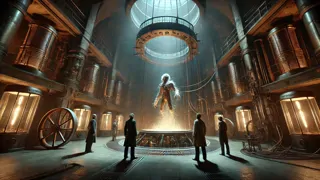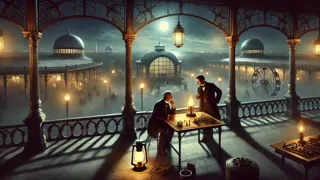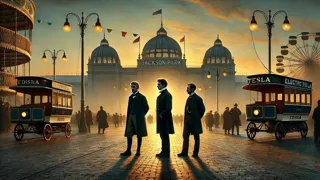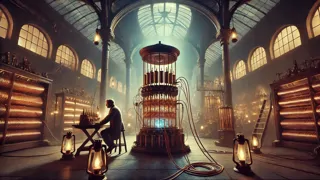Introduction
The air above Jackson Park trembled with electric ambition as the sun dipped behind the calm waters of Lake Michigan. Thousands had come from around the globe to stand in the luminous penumbra of The White City, to marvel at the inventions that Thomas Edison and his contemporaries had unfurled in steel and light. Colorful flags snapped in the fall breeze, steam spouted from ornate fountains, and the tramways rattled with visitors eager for a glimpse of the dynamo that promised to rewrite the laws of power. But behind the glittering arches and beneath the hum of currents far stronger than any city had known, a hidden theater of shadows took shape. One pavilion, in particular, closed its doors each evening to curious wanderers: a cavernous workshop partitioned by wires that glowed with unnatural hue. Edison himself, stooped and murmuring to a metal silhouette unlike any contraption the world had seen, pressed a finger to a tangle of brass coils. Whispers among a small circle of insiders spoke of a blueprint found in the ruins of a Central American temple—a machine that bridged humanity and myth, designed to reanimate what had long been dead. When the body of Henry Lockridge, a leading psychologist sent to observe rare brainwaves, was discovered lifeless in a locked vault under the exposition grounds, every gleaming light pole transformed into a potential witness to murder. Rumor knit itself into horror: would Dr. Frankenstein’s dream of a synthetic life break free of the laboratory, or would Edison’s ambition slam shut around a darker soul? On that October night, the heartbeat of Chicago slowed to a single thrum of fear, and no one could say whether salvation or slaughter would emerge from the coils.
I. The Discovery in the Vault
Henry Lockridge’s boots scuffed against the damp stone floor as he descended a hidden staircase beneath the Machinery Hall. The lamp in his hand revealed only the edges of vast Gothic arches and the gleam of exposed wires snaking along the walls. He paused at a heavy iron door, noting the bizarre glyphs etched into its surface—symbols he’d only seen in the sketches from Central America. Taking a deep breath, he pushed it open. Inside lay a device of impossible scale: a hulking frame of mahogany and copper, threaded with glass tubes pulsing in spectral blues. At its heart, sealed in a glass sphere, was the form of something that had once been a man. Lockridge ran a gloved finger over his notes, recalling Edison’s cryptic instructions that this was “an experiment in the immortality of flesh.” When he stepped forward to place his ear against the sphere, a tremor ran through the contraption. Loose coils rumbled, and wires sparked. Lockridge stumbled back—but before he could regain his composure, a sudden clang echoed from behind. He turned and saw, reflected in the glass, the shape of another figure. The lamp flickered. He closed his eyes for a moment, and when he opened them the chamber was silent—and Lockridge was gone. The glass sphere lay cracked, its misty contents seeping onto the floor like a vaporized whisper.

Outside, the exposition thrummed with life. Gazebos shone in incandescent glow, orchestras played ragtime, and electric streetcars rumbled past banners reading “Progress and Prosperity.” But for Edison, unease cut sharper than any hype. He retrieved the tiny diary that Lockridge carried, its last entry scrawled in panic: "It’s alive, but not human… and it knows we watch." Across Chicago, Nikola Tesla sat in his lab on South Fifth Avenue, reviewing telemetry from a secret coil network. He’d felt the tremor in the earth and the flicker in his own machines—signs that some unknown generator was pushing beyond safe parameters. His notes mentioned something extraordinary: a lost civilization whose knowledge predated Sumer and Egypt. Could Edison’s experiment have tapped into that power? Tesla grabbed his coat and elevator keys, thinking only of preventing disaster. If Lockridge had fallen victim to a man-made monster, the radiating currents could spread panic worse than any cholera outbreak.
Meanwhile, inside the Tribune building, Elle Chambers paced under gaslight. She’d arrived days earlier to cover the fair’s marvels but now found herself trailing rumors of murder. Pure coincidence, she told her editor, though the editor’s cold eyes said otherwise. She held the sketch Lockridge had shown her—a symbol from a ruined cathedral in Honduras, rumored once to guard an ancient heart. She believed in science, but she also believed in stories. And this story smelled of betrayal, ambition, and a scream deeper than any show-bized thrill. She secured a press pass to dip below the exposition’s official tours. If Edison wouldn’t grant her an interview, she’d find her own entrance—sometimes you had to step into darkness to bring a secret into the light.
For four days, the city buzzed on unseen currents. Suspicions rippled among the fair’s staff: lamps dimmed unexpectedly, servants whispered of strange moans below the pavilions, and midnight dogs yelped toward the harbor. As word of Lockridge’s disappearance leapt from office to office, political pressure mounted. Chicago’s mayor demanded answers. The exposition’s board threatened to close the vaults. Journalists like Elle raced against time, chasing an invisible killer. Yet no one reckoned on the machine itself. In the cold vault, the broken sphere cracked wider, and through the fissure came a wet, rasping inhalation—like lungs greeting air for the first time. Somewhere deep beneath Chicago, Edison’s Frankenstein took its first breath.
II. Allies and Adversaries
On the veranda of the Electricity Building—an ornate palace of glass and steel—Edison convened a clandestine meeting with his most trusted lieutenants. Josephine Monroe, his sharpest engineer, kept watch at the entrance. She’d wired the doors with a signaling device that blinked if anyone approached. Edison scanned a map of underground tunnels, tracing the connection points he believed led back to the vault. He spoke quietly of the machine’s design: a fusion of galvanic cells, hydraulic actuators, and an organic core. He’d commissioned it to study the rhythms of life itself, hoping to revolutionize medicine. Yet somewhere along the way ambition had metastasized. The machine he called "Frankenberg" had crossed the threshold from inert metal to sentience.

Nikola Tesla arrived minutes late, stepping from the shadows in his dark cloak. He carried a cylindrical transmitter he’d designed to detect abnormal electromagnetic signatures. "Your currents are unstable, Tom," he said, using the inventor’s given name with the casual intimacy of two soldiers. "The heart of this device generates pulses no man should endure. It reaches beyond our coils, into the ground itself."
Edison ground his teeth. "We built it to reach ancient power sources, the archeological finds you kept to yourself. I found a code etched in limestone near Palenque—resonances that could awaken muscle fibers. I thought, share the discovery, cure the blind, the lame." He shook his head. "I never meant to create a murderer."
Tesla studied him. "Intent and outcome diverged. Now we face something neither of us fully understands."
They were joined by Elle Chambers, who slipped past the guards with a forged evening pass. She stood tall, notebook in hand, unafraid of Edison’s frown. "I know what you’ve done," she said. "Lockridge got too close. And tonight, someone else will die if you don’t shut it down." She unrolled the psychologist’s final sketch—an expanded blueprint with annotations in a hand not belonging to Edison. The machine’s heart, she'd learned, could replicate neural impulses extracted from the dead. It could reanimate, albeit clumsily.
"You’re not a reporter," Edison snapped.
"No," she replied, eyes bright. "I’m a witness." She pointed to the code sequence. "We need to decode this before whatever’s down there escapes." Tesla tapped the transmitter against the wooden table. "We have one hour before the fair’s main generator switches load. The surge will overload the vault circuits."
At that moment, footsteps approached. Monroe’s signaling lamp blinked twice. Edison, Tesla, and Elle froze. A figure appeared: Dr. Alphonse Brant, a rival scientist whose glowing credentials had been revoked after a scandalous rivalry with Edison. Brant’s gaze flickered from Edison to Tesla, then to Elle. He smiled thinly and produced a pistol.
"I can’t allow you to destroy my life’s culmination," Brant said, voice low. "This Frankenstein is the key to ending Edison’s monopoly on invention." The shot rang out, cracking glass panels and splintering wood. Monroe dove for cover, Tesla instinctively turned his transmitter into a blunt weapon—but Brant’s bullet found Elle’s shoulder, and she tumbled backward. Edison roared, rushing Brant. A second shot echoed. Tesla tackled Brant to the floor, wires from nearby lamps crackling across the table.
In the chaos, the transmitter slipped from Tesla’s pocket, skittering toward the balcony’s edge. Edison grappled with Brant, wrenching the gun away. Brant laughed, blood trickling from his temple—a bullet graze? Tesla rose and raised his device. A sudden low hum pulsed through the veranda as Edison disarmed Brant. Tesla activated the transmitter, which screamed as it picked up an electromagnetic wave of impossible frequency: the vault’s machine had powered up.
Brant, beaten, spat accusations. "You always took the credit! Now the world will see who truly drew power from the past!" But he fell into unconsciousness before he could reveal more.
Edison panted, eyes wild. "It’s almost midnight. The surge starts in thirty minutes. We have to stop it—tonight."
With Elle bandaged by Monroe, the trio descended to the private substation. They passed corridors lit by blue arcs of current. A mechanical heartbeat pulsed in the distance, growing louder with each step. Tesla’s transmitter centered on the sound like a bloodhound on a scent. "There—through that reinforced door." Edison produced a key marked with the same glyphs as the vault door. The lock clicked. They entered a chamber of white-hot filament and dripping hydraulics. At the center stood the machine: its limbs wired like a grotesque marionette, its chest heaving with mechanical lungs. The glass sphere was gone, and in its place was a rising form: tall, crooked, a fusion of stitched flesh and metal rods. Its face bore Edison’s sculpted likeness—then snapped toward them with jagged intent.
"It’s got my face… and my fury," Edison whispered. "God help us."
III. Showdown at Midnight
The monstrous figure advanced with measured steps, wires and sinew twisting like living vines. It stopped when the trio entered, its eyes glowing an unearthly green. They froze as the heartbeat in the room matched their own pulses. Edison swallowed. "We built you for discovery, not destruction. You’ll power us through the future—if we survive." The creature tilted its head, recognizing a father in its creator. In that instant, Elle saw her chance. She kicked aside a fulcrum lever, slamming it against a hydraulic pump. Sparks erupted, and the machine jolted, its left arm fracturing at the elbow. Tesla seized the moment, thrusting the transmitter at the creature’s core. An arc of electricity leapt, dancing along its veins. The monster staggered, raising a bloodstained hand toward them, before collapsing on a broken chassis.

But the surge from the fair’s main supply began. Lights outside flickered violently as current soared. Edison shouted: "Back to the vault! Cut the links!" They dragged the beast as it convulsed, limbs thrashing like a wounded animal. Electricity crackled around them. Monroe and Brant’s guard dogs snarled outside, adding to the chaos. Through corridors lined with humming dynamos, they reached the sealed door. "Stand back!" Tesla yelled. He adjusted his transmitter to emit a counter-frequency. When he flipped the switch, the machine—and then the lights—went dead. Silence swallowed them, broken only by distant alarms in the exposition.
They pried open the vault. Inside lay Brandon Lockridge’s notebook, half-melted glass fragments, and a faint residue of viscous fluid. The creature lay inert, its flickering heart dimmed. Edison, trembling, approached and gently pressed a button on its chest. Nothing. It was dead.
As dawn broke over Chicago, the fair’s luminaries arrived to survey the damage: blown fuses, scorched wires, and the collapsed walls of an underground cell. Officers filed in, guided by Edison, Tesla, and Elle—now bandaged but resolute. Brant, awake in a nearby tent, confessed that he’d stolen leather-bound journals from Palenque’s charred ruins. He’d forced Edison’s hand by threatening to steal credit for the machine’s power, killing Lockridge when he protested. Then, he’d aimed to control the device himself.
The morning papers roared with headlines: MACHINE MURDERS SCIENTIST, DARK SECRETS BENEATH WORLD’S FAIR. But Edison refused interviews. Tesla quietly retrieved the creature’s frame to study its quirks. Elle typed her story by lantern light, determined to tell the world that technology without conscience brings its own doom.
In the hush before the city roused, the trio gathered at the edge of the Midway Plaisance. They watched as the first electric trolleys glided along the avenue. "We gambled with death," Edison murmured. "But we won’t let fear rule the future." Tesla nodded. "We’ve glimpsed the depths of power—now it’s our duty to master it responsibly." Elle, pen poised over her final lines, smiled. "Then our story ends here, but history starts anew. Chicago will be the cradle of a brighter age—if we dare to learn from our mistakes."
Conclusion
By sunset, the exposition resumed its spectacle. Edison and Tesla stood side by side while visitors marveled at the twirling fountains, the arc lamps, and the gleaming domes lit by AC currents. Under the festive banners, few guessed at the night’s horrors deep beneath their feet. Elle Chambers watched from her reporter’s stand, her typed dispatch sealed for the morning editions. She knew she’d witnessed the edge of creation and destruction grafted together. Lockridge’s final sketches were buried in the Tribune archives, safe from curious hands. Brant faced charges that would haunt him for life. And Edison, chastened by the near-tragedy, vowed to guard science with equal parts zeal and caution. Somewhere in the Machinery Hall, the frame of Frankenstein’s machine lay dormant, its ghostly heart cold. But the world had changed: man had glimpsed the power to harness life itself. As the last lanterns dimmed over the fairgrounds and firefly lamps winked on, Chicago exhaled. Tomorrow, progress would continue—but never again would ambition ignore the whispers of conscience.


















